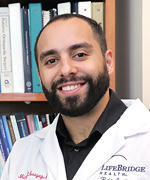Malunion
What is a malunion?
When a fractured bone does not heal in a proper position, it is called a “malunion.” For example, the bone may be shorter than usual, or the bone may be twisted, rotated, or bent in a bad position. More than one of these deformities may be present. The most common place for malunions is in the tibia (shin bone), and the next most common is the forearm.
Malunions can cause significant functional impairment for patients based on the type of deformity and the involved bone. The symptoms of malunions can be pain, swelling, limping, difficulty wearing shoes and limited mobility. Malunions can cause stretching or entrapment of the nerves based on the anatomical location. In this situation, numbness or tingling and muscle weakness or atrophy might be the main symptoms in patients.
If the malunion is short, the leg length inequality can lead to back pain. Crooked legs can cause excessive pressure on the knee leading to premature arthritis of the knee. While it is possible to walk on a malunited tibia, the long term effects on the knee can be severe. It is like driving a car with the front end out of alignment. You can drive the car, but the tires are going to wear out prematurely.
What causes malunions?
A malunion in adults can happen due to not seeking treatment soon enough (or at all), inadequate immobilization in the cast, premature cast removal and weight bearing, or ineffective surgical internal or external fixation to correct the fracture. In children, partial or complete growth plate damage during trauma, or overgrowth of the long bones after fracture treatment, can lead to limb length discrepancy or angulation deformities.
How are malunions diagnosed?
Diagnosis is based on the patient’s history and proper physical examination as well as X-rays. Sometimes, an MRI and/or a CAT scan is needed in addition to standard X-rays for diagnosis and surgical planning.
How are malunions treated?
Treatment strategy is based on the patient’s symptoms, the severity of the condition and functional impairment. In most scenarios, a surgical intervention is needed to solve the problem. Surgery consists of re-cutting, re-setting and fixing the bone in the proper anatomical and functional position. In cases with shortening of long bones, limb lengthening by using an internal or external device can equalize the limb length and eliminate the limp caused by a short leg.
All patients should quit smoking to prevent nonunion or delayed union. Sometimes, the limb will be immobilized in a cast or splint for a short period of time, and the patient will need to use a walker or crutches for movement (ambulation). Usually sutures will be removed in the first follow-up visit. Physical therapy can help patients to gain their optimum function after surgery. Regular follow up is needed to evaluate the healing process or possible treatment adjustment in the postoperative course. X-rays will be taken during follow-up visits to check the healing process and alignment of the bone.
Why choose the International Center for Limb Lengthening to treat a malunion?
Deformity correction and limb lengthening are complex processes. Your doctor at the International Center for Limb Lengthening will take the time to make sure you understand all your options and then will customize your treatment to meet your specific needs. Our patients benefit from our team-centered approach with world-renowned surgeons and specialized physician assistants, nurses and physical therapists. We help patients with malunions achieve their best possible result.
Chat with a doctor about malunions
Our doctors hold free monthly chats on various subjects, including malunions. Click here for more information about our monthly chats.
Doctors who treat malunions
*Patients Over 16 Years Old Only







